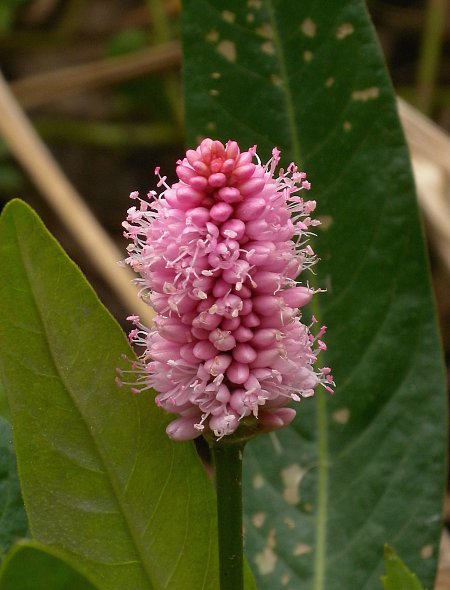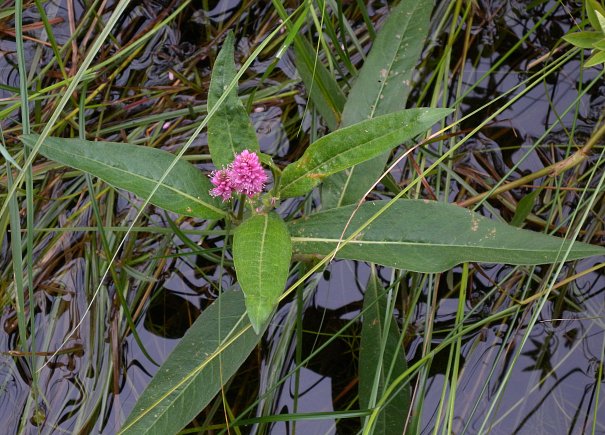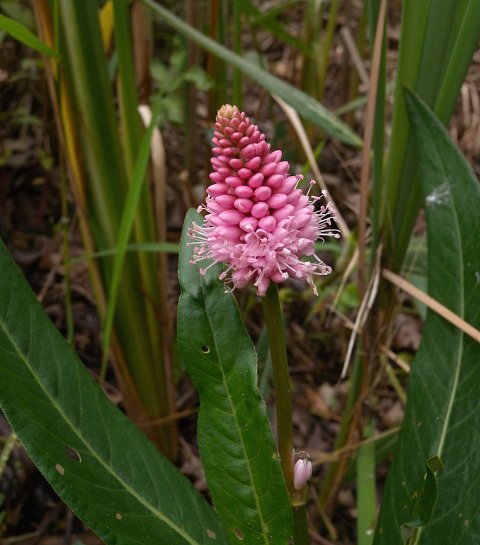
For both terrestrial and aquatic forms of this plant, the upper stems terminate in 1-2 spike-like racemes of flowers. These racemes are ¾–1½" long, ½–¾" across, and ovoid-conical to short-cylindrical in shape; the flowers are densely distributed along the racemes, facing horizontally in all directions. The peduncles of these racemes are up to 3" long, light to medium green, terete, relatively stout, and glabrous or nearly so. Individual flowers are 4-6 mm. (up to ¼") in length; each flower has 5 pink to rosy pink sepals, 5 stamens with white filaments and pink anthers, and a pistil with a style that is divided above. The flowers are usually perfect, although sometimes unisexual (male or female) flowers are produced. The sepals are oval in shape and spread outward slightly when they are fully open. The blooming period occurs sporadically from mid-summer into autumn, lasting 2-3 months. Some individual plants fail to bloom. Afterwards, each fertile flower is replaced by a single seed. Mature seeds are 2–3.5 mm. long and a little less across; they are broadly ellipsoid or ovoid, somewhat flattened, and brown. The root system is rhizomatous or stoloniferous, from which clonal plants can develop. Fibrous roots can develop from the nodes of the stems and produce clonal plants if they establish contact with moist to wet ground.

Cultivation: The preference is full or partial sun, wet conditions (including water up to 6' deep), and soil containing sand, silt, or muck. This plant assumes a terrestrial form when it is planted on wet ground or shallow water, while in deeper water it assumes an aquatic form.
Range & Habitat: The native Water Smartweed is occasional in northern Illinois, becoming less common in the central and southern sections of the state (see Distribution Map). Unfortunately, the distribution map combines the records of Scarlet Smartweed (Persicaria coccinea) and Water Smartweed (Persicaria amphibia) because these two species are sometimes regarded as synonymous; this viewpoint is rejected here. Water Smartweed is widely distributed in the northern United States and Canada; it also occurs in Eurasia and parts of Africa. Habitats include marshes, swamps, borders of small lakes and ponds, shallow water of small lakes and ponds, wet sloughs and swales, and deep ditches. These habitats include both sandy and non-sandy wetlands. In Illinois, this plant is found primarily in high quality wetlands where there is some protection from prevailing winds and an absence of significant water currents.

Faunal Associations: The flowers of smartweeds (Persicaria spp.) are cross-pollinated by bees, wasps, flies, and small to medium-sized butterflies. Insects that feed on the foliage and other parts of smartweeds include Chaetocnema concinna (Brassy Flea Beetle), Disonycha pensylvanica (Striped Smartweed Beetle), Disonycha uniguttata (leaf beetle sp.), Galerucella nymphaeae (Waterlily Leaf Beetle), and the larvae of such moths as Chionodes discoocellella (Eye-ringed Chionodes), Costaconvexa centrostrigaria (Bent-line Carpet), Maliattha synochitis (Black-dotted Maliattha), and Pseudeustrotia carneola (Pink-barred Pseudeustrotia). The larvae of two butterflies, Lycaena helloides (Purplish Copper) and Lycaena hyllus (Bronze Copper), also feed on smartweeds occasionally. Water Smartweed is a probable host plant for the stem-boring larvae of a weevil, Lixus rubellus. In addition to these insects, several aphid species and the larvae of some sawflies (Ametastegia spp.) feed on these plants (Clark et al., 2004; Harms & Grodowitz, 2009; Covell, 1984/2005; Marshall, 2006; Bouseman & Sternburg, 2001; Pepper, 1965; Blackman & Eastop, 2009; Smith, 2006). Among vertebrate animals, the seeds or seedheads are importance sources of food for ducks, rails, and other wetland birds (see Bird Table). Some turtles, including Chrysemys picta (Painted Turtle), Chelydra serpentina (Snapping Turtle), and Trachemys scripta (Slider), reportedly feed on these plants (Lagler, 1943; Ernst et al., 1994). Muskrats use smartweeds only to a limited extent, feeding on their lower stems or rhizomes (Hamerstrom & Blake, 1929; Martin et al., 1951/1961).
Photographic Location: A sandy marsh and sandy swale near Lake Michigan in NE Illinois. The photographed plants are the terrestrial form of Water Smartweed, Persicaria amphibia emersa.

Comments: The flowers of this smartweed are showier than those of other smartweeds (Persicaria spp.). Water Smartweed (Persicaria amphibia) is easy to identify when the floral racemes are present as they are noticeably stouter than those of other smartweeds in Illinois. The terrestrial form (or variety) of this smartweed is referred to as Persicaria amphibia emersa, while the aquatic form (or variety) is referred to as Persicaria amphibia stipulacea. The Eurasian form (or variety) of this plant is referred to as Persicaria amphibia amphibia. While some sources (ITIS website, USDA website) regard Scarlet Smartweed (Persicaria coccinea) and Water Smartweed (Persicaria amphibia) as the terrestrial and aquatic forms of the same species (Persicaria amphibia), this viewpoint is rejected by other sources (see Mohlenbrock, 2014; New England Wildflower Society website) and it is not accepted here. The floral racemes of Scarlet Smartweed are narrowly cylindrical (about 6-8 mm. across and 1-5" long) for both the aquatic and terrestrial forms of this species, while the floral racemes of Water Smartweed are much stouter (12-18 mm. across and ¾–1½" long). There are also consistent differences in the hairiness of peduncles and the presence or absence of curled upper rims on the ocreae for these two species, regardless of whether their forms are terrestrial or aquatic. A scientific synonym of Water Smartweed is Polygonum amphibium.